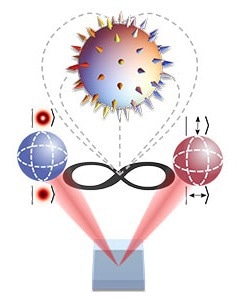In partnership with String Theorist Robert de Mello Koch of Huzhou University in China (formerly from Wits University), researchers from the Structured Light Laboratory (School of Physics) at the University of the Witwatersrand in South Africa, under the direction of Professor Andrew Forbes, have shown for the first time that it is possible to perturb pairs of spatially separated yet interconnected quantum entangled particles without changing particles shared properties.

Image Credit: University of the Witwatersrand
We achieved this experimental milestone by entangling two identical photons and customizing their shared wave-function in such a way that their topology or structure becomes apparent only when the photons are treated as a unified entity.
Pedro Ornelas, Lead Author and MSc Student, Structured Light Laboratory, School of Physics, University of the Witwatersrand
Quantum entanglement, sometimes known as “spooky action at a distance,” created the link between the photons and allowed particles to affect one another’s measurement results even when the particles were separated by large distances. On January 8th, 2024, the study was published in Nature Photonics.
In this work, the function of topology and its capacity to preserve properties are compared to the process of reshaping a coffee cup into the shape of a doughnut; in the process, the mug changes in appearance and shape, but a single hole, a topological feature, stays constant and unaltered.
In this way, the two objects are topologically equivalent.
The entanglement between our photons is malleable, like clay in a potter’s hands, but during the molding process, some features are retained.
Andrew Forbes, School of Physics, University of the Witwatersrand
The investigation delves into the Skyrmion topology, originally studied by Tony Skyrme in the 1980s. This exploration focuses on field configurations that exhibit particle-like traits. Within this framework, topology signifies a universal aspect of the fields, much like a fabric (the wave-function) whose texture (the topology) remains consistent regardless of the direction it is manipulated.
Since then, these ideas have been realized in liquid crystals, contemporary magnetic materials, and even optical analogs that use traditional laser beams. Skyrmions are highly regarded in condensed matter physics because of their stability and resistance to noise, which has resulted in significant breakthroughs in high-density data storage devices.
Forbes says, “We aspire to see a similar transformative impact with our quantum-entangled skyrmions.”
Earlier studies portrayed Skyrmions as localized entities confined to a specific location. Ornelas says, “Our work presents a paradigm shift: the topology that has traditionally been thought to exist in a single and local configuration is now nonlocal or shared between spatially separated entities.”
Building upon this concept, the researchers leverage topology as a framework to categorize or differentiate entangled states. The scientist envisages that “this fresh perspective can serve as a labeling system for entangled states, akin to an alphabet!” says Dr. Isaac Nape, a co-investigator.
Nape says, “Similar to how spheres, doughnuts, and handcuffs are distinguished by the number of holes they contain, our quantum skyrmions can be differentiated by their topological aspects in the same fashion.”
The group anticipates that this will develop into a potent instrument that opens the door for novel quantum communication protocols to process quantum information across entanglement-based channels by using topology as an alphabet.
The article’s findings are significant because creating methods to maintain entangled states has been a challenge for decades for scientists. The observation that topology does not change as entanglement decreases points to a possible novel encoding mechanism that makes use of entanglement, even in situations where conventional encoding protocols would break down due to low entanglement.
Forbes says, “We will focus our research efforts on defining these new protocols and expanding the landscape of topological nonlocal quantum states.”
Journal Reference:
Ornelas, P., et al. (2024). Non-local skyrmions as topologically resilient quantum entangled states of light. Nature Photonics. doi.org/10.1038/s41566-023-01360-4.
Source: https://www.wits.ac.za/